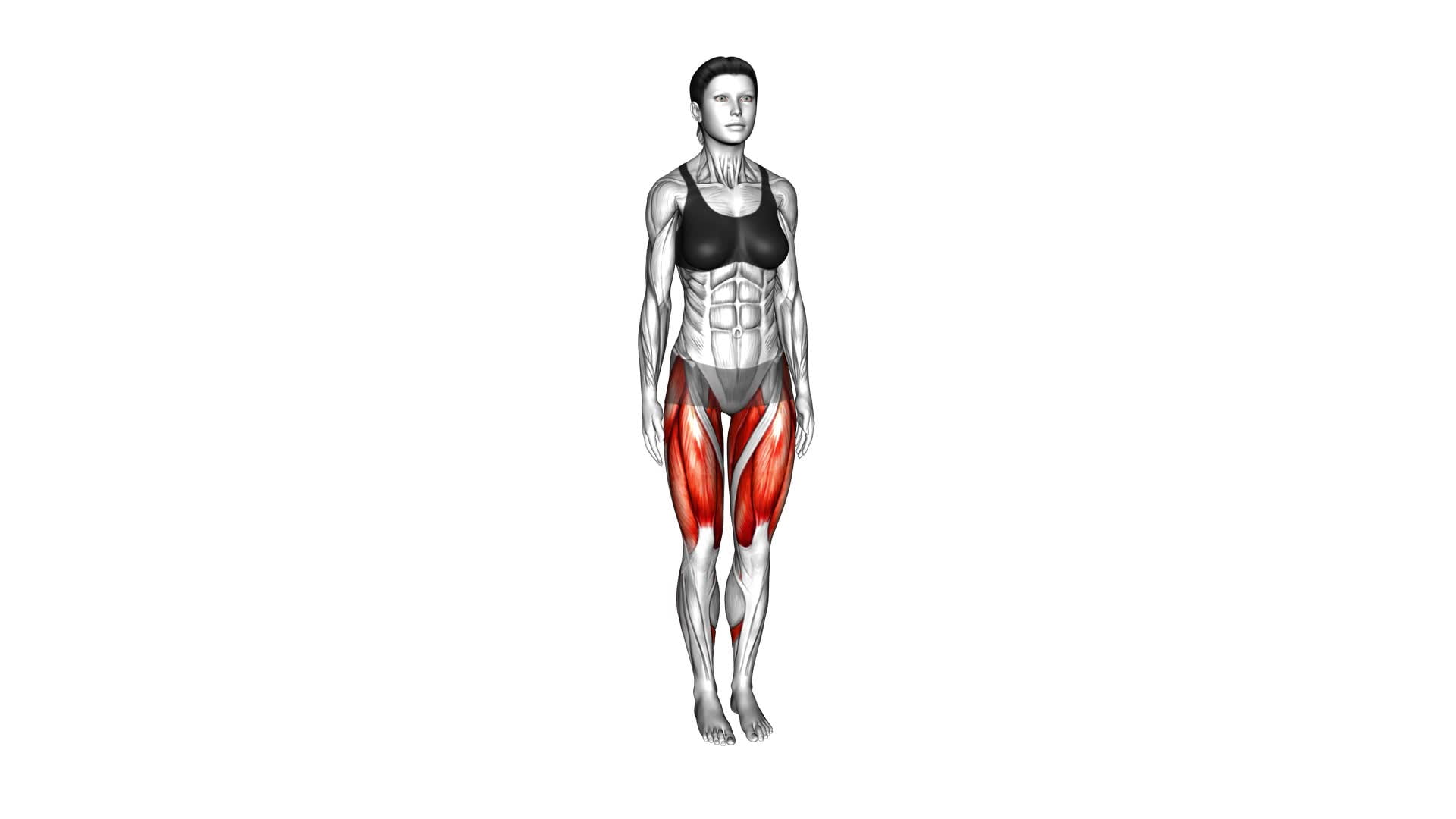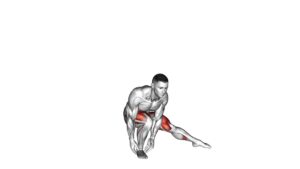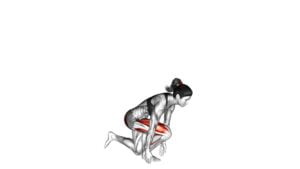Alternate Heel Touch Side Kick Squat (female) – Video Exercise Guide & Tips

Are you looking for an effective lower body exercise that targets multiple muscle groups? Look no further than the Alternate Heel Touch Side Kick Squat!
Watch This Exercise Video
This exercise combines the benefits of squats, side kicks, and core engagement. In this video exercise guide, we'll show you how to properly perform this move to maximize results and minimize the risk of injury.
Plus, we'll share tips for increasing intensity and modifications for all fitness levels.
Let's get started!
Key Takeaways
- The alternate heel touch side kick squat is a beneficial exercise for improving lower body strength and flexibility.
- It targets the quadriceps, hamstrings, glutes, and calves, leading to muscle activation and growth.
- The exercise can contribute to weight loss and is an efficient and effective way to strengthen and increase flexibility in the lower body.
- To increase the intensity, one can use heavier weights, increase repetitions, slow down the movement, or incorporate variations such as the weighted or jumping heel touch side kick squat.
Benefits of the Alternate Heel Touch Side Kick Squat
One benefit of the Alternate Heel Touch Side Kick Squat is improving overall lower body strength and flexibility through the combination of dynamic kicks and squats. This exercise targets several key muscle groups, including the quadriceps, hamstrings, glutes, and calves, which helps in strengthening your legs. By incorporating kicks into the squat movement, you're engaging the muscles in a more dynamic and challenging way, leading to increased muscle activation and growth.
In addition to strengthening your legs, the Alternate Heel Touch Side Kick Squat can also contribute to weight loss. This workout is a compound exercise that requires multiple muscle groups to work together, resulting in a higher calorie burn during and after the workout. The more intense the exercise, the more calories you can potentially burn, which can aid in achieving your weight loss goals.
By combining the benefits of strengthening your legs and promoting weight loss, the Alternate Heel Touch Side Kick Squat is an efficient and effective exercise for improving overall lower body strength and flexibility.
Now, let's move on to the next section and learn how to perform this exercise correctly.
How to Perform the Alternate Heel Touch Side Kick Squat
To perform the Alternate Heel Touch Side Kick Squat, start by standing with your feet shoulder-width apart. Follow these steps to execute the side kick technique with proper squat form:
- Begin by bending your knees and lowering into a squat position. Keep your chest lifted and your core engaged.
- As you squat down, shift your weight onto your left leg and lift your right leg off the ground.
- Engage your glutes and quads to maintain balance and stability.
- Keep your right leg straight and extend it out to the side, aiming to touch your right heel with your right hand.
- Return your right leg to the starting position and repeat the movement on the opposite side.
- Shift your weight onto your right leg and lift your left leg off the ground.
- Extend your left leg out to the side and try to touch your left heel with your left hand.
- Continue alternating between sides, performing controlled squats and side kicks.
- Remember to maintain proper squat form throughout the exercise, keeping your knees aligned with your toes and your back straight.
- Focus on engaging your core muscles to stabilize your body and enhance the effectiveness of the exercise.
Common Mistakes to Avoid During the Alternate Heel Touch Side Kick Squat
Now let's address some common mistakes you should avoid when performing the Alternate Heel Touch Side Kick Squat.
Proper form is crucial to get the most out of this exercise and prevent injury.
One common mistake isn't engaging your core muscles. It's important to keep your core tight throughout the movement to maintain stability and control.
Another mistake to avoid is leaning too far forward or backward. This can put strain on your lower back and reduce the effectiveness of the exercise. Instead, focus on keeping your torso upright and your weight centered over your standing leg.
Additionally, be mindful of your knee alignment. A common mistake is allowing your knees to collapse inward or overextend past your toes. To prevent this, make sure your knees stay in line with your toes throughout the movement.
Lastly, avoid rushing through the exercise. It's important to perform each repetition with control and proper technique. Take your time and focus on maintaining proper form throughout the entire set.
Tips for Increasing the Intensity of the Alternate Heel Touch Side Kick Squat
To increase the intensity of the Alternate Heel Touch Side Kick Squat, challenge yourself by using heavier weights. By incorporating heavier weights into your workout, you can effectively target and strengthen your lower body muscles. Here are some tips for increasing the intensity of this exercise:
- Progressive overload: Gradually increase the weight you use for the squat to continuously challenge your muscles and promote growth.
- Increase the number of repetitions: Instead of doing the exercise for a set number of reps, try adding a few more reps each time you perform the workout.
- Slow down the movement: By slowing down the tempo of each rep, you can increase the time under tension for your muscles, making the exercise more challenging.
It is important to maintain proper form during the Alternate Heel Touch Side Kick Squat to prevent injuries and get the most out of your workout. Keep these tips in mind:
- Engage your core: Keep your abs tight throughout the exercise to stabilize your body and protect your lower back.
- Maintain a neutral spine: Avoid rounding or arching your back by keeping a straight and neutral spine.
- Control your movements: Focus on controlled and deliberate movements, avoiding any jerking or swinging motions.
By following these tips, you can maximize the intensity of the Alternate Heel Touch Side Kick Squat and achieve greater results.
Now, let's explore modifications and variations of this exercise.
Modifications and Variations of the Alternate Heel Touch Side Kick Squat
To further challenge yourself and add variety to your workout, you can modify and vary the Alternate Heel Touch Side Kick Squat.
There are several alternative exercises you can incorporate into your routine to target different muscle groups and keep your workouts interesting.
One modification you can try is the Weighted Heel Touch Side Kick Squat. This exercise involves holding a dumbbell or kettlebell in each hand while performing the side kick squat. The added weight increases the resistance and intensifies the workout, targeting your glutes, quadriceps, and hamstrings even more.
Another variation is the Jumping Heel Touch Side Kick Squat. Instead of performing a regular side kick squat, you can incorporate a jump into the movement. Start by squatting down and as you come up, explode off the ground and perform a side kick while in the air. This exercise adds an element of plyometrics, helping to improve your explosive power and cardiovascular fitness.
If you want to challenge your core stability and balance, you can try the Single Leg Heel Touch Side Kick Squat. Instead of using both legs, perform the side kick squat on one leg while keeping the other leg extended out in front of you. This variation engages your core muscles more intensely and helps to improve your balance and coordination.
Frequently Asked Questions
Can the Alternate Heel Touch Side Kick Squat Help Me Lose Weight?
The alternate heel touch side kick squat is a great exercise for toning your muscles. It can still be beneficial for toning your muscles and improving overall strength. However, it may not be the most effective for weight loss.
If you're looking for alternatives to this exercise, you can try other cardio-intensive workouts like running or cycling. These activities can help burn more calories and aid in weight loss.
Is the Alternate Heel Touch Side Kick Squat Suitable for Beginners?
The alternate heel touch side kick squat can be suitable for beginners with some modifications. To start, focus on mastering the squat and side kick separately before combining them.
Begin with a wider stance and perform a shallow squat. As you progress, you can deepen the squat and increase the height and power of the side kick.
Remember to maintain proper form throughout the exercise, engaging your core and keeping your back straight.
Can I Do the Alternate Heel Touch Side Kick Squat if I Have Knee or Hip Problems?
If you have knee or hip problems, there are alternatives to the alternate heel touch side kick squat that you can try. Instead of performing the exercise with a side kick, you can focus on doing squats without the kicking motion. This will help to strengthen your lower body without putting excessive strain on your knees or hips.
Additionally, you can consult with a fitness professional who can provide you with modifications specific to your condition to ensure that you can still work out effectively and safely.
How Often Should I Incorporate the Alternate Heel Touch Side Kick Squat Into My Workout Routine?
To incorporate the alternate heel touch side kick squat into your workout routine, it's important to understand how to properly perform the exercise.
Start by standing with your feet shoulder-width apart and your hands on your hips. Bend your knees and lower into a squat position, then lift one leg to the side while keeping your core engaged. Touch your heel with the opposite hand, then return to the squat position.
You can vary the intensity by adding weights or performing more reps for intermediate and advanced levels.
Will the Alternate Heel Touch Side Kick Squat Help Improve My Balance and Flexibility?
Improving your balance and flexibility is crucial for overall fitness.
The alternate heel touch side kick squat is an effective exercise that can help you achieve these goals. By incorporating this move into your routine, you'll challenge your core stability and enhance your lower body strength.
This exercise targets multiple muscle groups, including your glutes, quadriceps, and obliques. With consistent practice, you'll notice improvements in your balance, flexibility, and overall fitness level.
Conclusion
In conclusion, the alternate heel touch side kick squat is a dynamic exercise that targets the lower body, specifically the glutes, quads, and hamstrings. By incorporating side kicks and heel touches, this exercise challenges balance, coordination, and core stability.
It's important to maintain proper form and avoid common mistakes to maximize the effectiveness of this exercise. By following the provided tips and modifications, individuals can increase the intensity and tailor the exercise to their fitness level.
Incorporating the alternate heel touch side kick squat into a workout routine can help improve strength, stability, and overall lower body function.

Author
Years ago, the spark of my life’s passion ignited in my mind the moment I stepped into the local gym for the first time. The inaugural bead of perspiration, the initial endeavor, the very first surge of endorphins, and a sense of pride that washed over me post-workout marked the beginning of my deep-seated interest in strength sports, fitness, and sports nutrition. This very curiosity blossomed rapidly into a profound fascination, propelling me to earn a Master’s degree in Physical Education from the Academy of Physical Education in Krakow, followed by a Sports Manager diploma from the Jagiellonian University. My journey of growth led me to gain more specialized qualifications, such as being a certified personal trainer with a focus on sports dietetics, a lifeguard, and an instructor for wellness and corrective gymnastics. Theoretical knowledge paired seamlessly with practical experience, reinforcing my belief that the transformation of individuals under my guidance was also a reflection of my personal growth. This belief holds true even today. Each day, I strive to push the boundaries and explore new realms. These realms gently elevate me to greater heights. The unique combination of passion for my field and the continuous quest for growth fuels my drive to break new ground.







